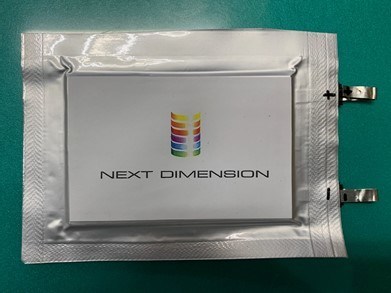Green Science Alliance Developed Rechargeable Aluminum Sulfur Battery Pouch Cell
Rechargeable batteries are a very important electrical device because they can store electricity produced by sustainable renewable energy such as wind power, solar power, hydrogen, fuel cells, geothermal power, wave power and biomass power generation, etc. Therefore, it is necessary to create a rechargeable battery which can be stronger and cheaper than currently used a lithium ion battery.
Green Science Alliance has been developing various types of next generation rechargeable battery technologies such as lithium sulfur battery, lithium rich cathode, silicon type anode, all solid state lithium ion battery, etc. Also they have developed a rechargeable aluminum air battery in the past. However, due to its complicated structure and unstable aluminum reduction reaction of aluminum ion to aluminum metal in the electrolyte, it was difficult to achieve commercialization.
This time, Dr. Ryohei Mori and Mr. Hiromichi Itanihave developed an actual aluminum sulfur battery pouch cell with aluminum anode, ionic liquid or deep eutectic solvent based electrolyte and carbon-sulfur composite cathode. The cell capacity was approximately 950 mAhg-1 at the beginning, but deteriorated to 200 mAhg-1 after 100 cycles, under 0.025 C at room temperature. Therefore, cyclability needs to be improved. In addition, cell voltage and applied current are lower than that of a lithium ion battery. The open circuit voltage of the prepared aluminum sulfur battery pouch cell was approximately 0.9 V. Even still, cell capacity is much larger especially at the beginning and an aluminum sulfur battery can be safer and cheaper than a lithium ion battery.
There are some research activities of the aluminum ion battery (theoretical capacity is smaller than an aluminum sulfur battery), aluminum sulfur battery at some research institute and universities. However, it is the first time in the world to prepare an actual aluminum sulfur battery pouch cell for commercialization.
Green Science Alliance has been developing lithium sulfur battery so that they have knowledge about sulfur-based cathode. This time, they have applied that knowledge to the aluminum sulfur battery in the good way. On top of that, Green Science Alliance synthesizes and prepares most of actual electrode, electrolyte materials within their company, which is the big advantage to create cutting-edge batteries since battery property critically depends on battery component materials.
However, it will be difficult to look at the possibility of applying aluminum sulfur battery to EVs (Electric Vehicles) at the beginning because it cannot accept high current at one time. But, aluminum sulfur batteries can work for a long time. That is why overall cell capacity is much larger than lithium ion batteries. Even still, potential application to sensor or IT can be the big business opportunity since they do not require high electrical current but expect to work for a long time.
Other good features of the aluminum sulfur battery are:
1. Theoretical capacity of aluminum sulfur battery is 1675 Wh/Kg (based on sulfur content) which is 7 - 8 times higher than that of lithium ion battery 200 - 243Wh/Kg.
2. Compared to lithium which has high risk of price soring and scarcity, aluminum is an abundant, rich natural resource and most recycled metal on earth. So, an aluminum based rechargeable battery can be cheaper.
3. Lithium ion batteries are flammable and can be dangerous. In contrast, aluminum sulfur batteries are chemically stable, non-toxic and not flammable including all battery components.
4. Since ionic liquid or deep eutectic solvent is used as electrolyte, prepared aluminum sulfur battery can be used up to 300 Celsius degrees.
They will keep improving cell capacity, cyclability as well as start sending out samples to cooperation company and investors.
Green Science Alliance | https://www.gsalliance.co.jp/en/














